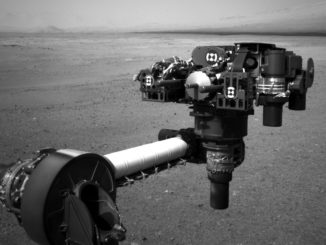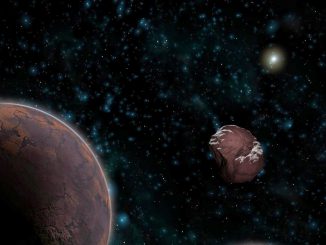
Making its fifth science pass close to Jupiter’s turbulent cloud tops, NASA’s Juno spacecraft sailed by the Solar System’s king planet Friday to collect another treasure trove of data on the giant world’s atmosphere, internal structure, and magnetic field.
The orbiter’s JunoCam imager was also turned on during Friday’s flyby to capture more scans of Jupiter’s swirling clouds to be stitched together and edited by the mission’s amateur fanbase.
The solar-powered spacecraft, armored with a titanium vault to shield its sensitive electronics from radiation, passed around 2,200 miles (3,500 kilometres) above Jupiter’s cloud tops around 0600 GMT (2 a.m. EDT) Friday. NASA reported the probe completed the flyby as planned, with all of its science instruments and camera operating.
Juno has logged 63.5 million miles (102 million kilometres) since arriving in orbit around Jupiter on July 4, 2016, ending a nearly five-year trip from Earth.
JunoCam’s raw images are available at www.missionjuno.swri.edu/junocam for the public to peruse and process into image products.
Juno has passed inside Jupiter’s radiation belts seven times, including the spacecraft’s arrival maneuver July 4, when the probe fired its main engine to enter orbit. Its instruments were deactivated during that encounter to focus on the make-or-break engine burn. The spacecraft entered safe mode just before a flyby in October, and it gathered no science data during that approach.
The Juno mission is designed to study Jupiter’s intense magnetic field and investigate the gas giant’s deep interior structure, revealing insights about its atmosphere and probing for a rocky core.

The Juno spacecraft is in an oval-shaped orbit around Jupiter that takes it around the planet once ever 53 days. NASA decided in February to forego an engine burn to move Juno into a closer 14-day orbit after engineers detected a problem with check valves inside the craft’s propulsion system last year.
Juno’s mission will last until at least February 2018, enough time to make 11 science orbits around Jupiter, instead of the 32 laps originally planned. But NASA could extend the mission another three years to give Juno more flybys near Jupiter.
The best data on Jupiter is captured when Juno is closest to the planet, but the 53-day orbit also gives scientists other opportunities that would not have been available in the mission’s original flight plan.
Scientists say the higher orbit allows Juno to move through Jupiter’s magnetotail, the part of the magnetic field bubble around the planet that is blown back like a comet’s tail by the solar wind. Such a perspective will allow Juno’s science team to study the complex network of magnetic field lines around Jupiter, and help sort out the drivers behind Jupiter’s auroras, separating auroras induced by internal convection and the solar wind.
Juno’s next close encounter with Jupiter is scheduled for July 11, when the spacecraft will fly over Jupiter’s Great Red Spot.
Email the author.
Follow Stephen Clark on Twitter: @StephenClark1.



